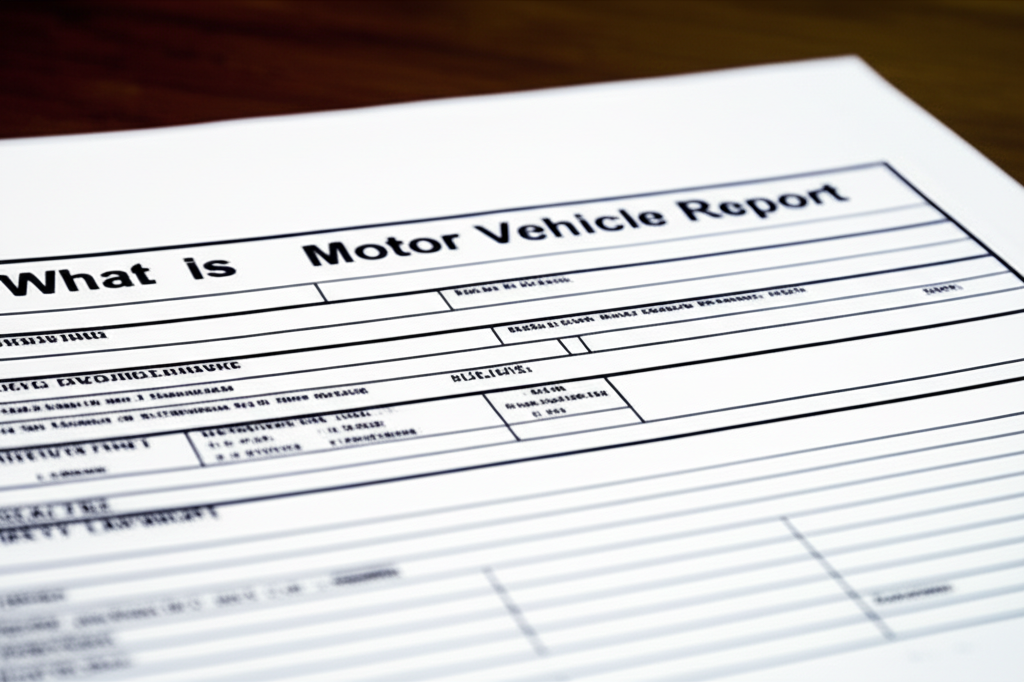
What Is a Motor Vehicle Report (MVR)? My Straight‑Talk Guide to Driving Records
Table of contents
- Introduction: Why your MVR matters more than you think
- What exactly is a Motor Vehicle Report (MVR)?
- Official definition and purpose
- MVR vs driving record vs driving abstract
- What information does an MVR contain?
- Identification details
- Traffic violations and convictions
- Accident history
- Points and license actions
- License status and endorsements
- Certified MVRs
- How far back does an MVR go?
- Standard look‑back periods
- Extended periods for serious offenses
- CDL and employer requirements
- Who uses your MVR and why?
- Auto insurance companies
- Employers and DOT compliance
- Car rental agencies and volunteer programs
- Your own use
- How to get your Motor Vehicle Report
- Where to request it
- Online, mail, and in‑person options
- Required info, fees, and processing time
- Third‑party providers and FCRA considerations
- How your MVR affects insurance, jobs, and privileges
- Insurance rates and driver risk assessment
- Employment screening and ongoing monitoring
- License restrictions and reinstatement
- What counts as a “good” MVR
- How to dispute errors and improve your MVR
- Checking your record for accuracy
- How to dispute mistakes
- Your rights under the FCRA
- Strategies to improve a driving record
- How to interpret MVR codes and points
- Common abbreviations and codes
- Points systems and their impact
- FAQs I get all the time
- CLUE report vs MVR
- National motor vehicle report
- How to clear or update your MVR
- How long things stay on an MVR
- Who can access your MVR and why consent matters
- A quick analogy that helped me understand MVRs
- Conclusion: Take control of your driving history today
Introduction: Why your MVR matters more than you think
The first time I pulled my Motor Vehicle Report, I thought I knew what I’d find. A couple speeding tickets. Nothing dramatic. Then I saw a license suspension I didn’t expect due to an insurance lapse from years back. That single line explained why my auto insurance rate felt high for a while. It also taught me a lesson. Your driving history holds more weight than you think.
So what is a Motor Vehicle Report exactly. It’s your official driving history as recognized by your state’s Department of Motor Vehicles or equivalent agency. Insurers check it when they price your policy. Employers review it when your job involves driving or operating a company vehicle. You should review it too because mistakes happen.
Here’s the key takeaway I wish I’d learned sooner. An MVR isn’t just a list of tickets. It’s a comprehensive driver profile that shows who you are on the road.
What exactly is a Motor Vehicle Report (MVR)?
Official definition and purpose
A Motor Vehicle Report is an official document that summarizes your driving record. The state driver’s license agency maintains it. Most people call that agency the DMV though names vary. The MVR is used to assess risk and confirm your license status for insurance pricing, employment screening, fleet driver monitoring, and even car rentals.
In plain language. It’s a standardized way for insurers, employers, and government agencies to see your driving history without guessing.
MVR vs driving record vs driving abstract
I hear this a lot. Are a Motor Vehicle Report, a driving record, and a driving abstract the same thing. Most states use these terms interchangeably for the same concept. Some states prefer “driver abstract” or “driving record” in their forms. A few use “certified MVR” for a stamped or sealed version that’s legally verifiable. The differences are mostly about terminology and formatting not substance.
What information does an MVR contain?
Every state formats it differently. The core pieces show up almost everywhere.
Identification details
- Full name, date of birth, and address
- Driver’s license number
- License class and endorsements
- License issue date and expiration date
- License status such as valid, suspended, or revoked
You’ll also see personal identifiers for verification. The state needs to confirm you’re you.
Traffic violations and convictions
This section gets the most attention. It typically includes:
- Moving violations such as speeding, failure to yield, reckless driving, improper turn, or failure to obey a traffic signal
- Serious offenses such as DUI or DWI, hit and run, leaving the scene, and in extreme cases vehicular manslaughter
- Citations and convictions including dates, codes, and sometimes court dispositions
If your state uses a points system you’ll usually see points assigned to each violation. The number of points and how long they stay vary by state.
Accident history
Accidents may appear on your MVR if they were reported to the DMV. Some states show at‑fault vs not‑at‑fault when that data is available. Many list date and location along with basic markers. Insurance carriers often have more detail in their own claim files. Your MVR is a high‑level record.
Points and license actions
If your state uses points for moving violations you’ll see point totals or entries. States sometimes suspend or restrict licenses after enough points. You’ll also see:
- Suspensions and revocations
- Reasons for the action such as DUI, insurance lapse, failure to appear, or too many points
- Dates and reinstatement requirements if available
License status and endorsements
Commercial drivers and some specialized roles carry endorsements. For example a CDL with hazardous materials or passenger endorsements. You’ll see restrictions too such as corrective lenses required.
Certified MVRs
A certified MVR is the same information plus an official stamp, seal, or digital certificate. Courts, employers, or agencies sometimes require a certified copy so they can rely on it as an official record.
How far back does an MVR go?
Standard look‑back periods
In my experience most insurers and employers look back three to five years for the majority of moving violations and minor accidents. That’s a common window for risk assessment. The exact period varies by state policy and by how a company chooses to underwrite or screen.
Extended periods for serious offenses
Serious offenses like DUI or DWI often remain visible longer. I’ve seen look‑backs in the seven to ten year range referenced in hiring guidelines and insurance underwriting rules. Some license actions show for even longer because the record of the action is part of the license history.
CDL and employer requirements
Commercial drivers face stricter standards. Employers often run MVR checks at hire and then at least annually for CDL drivers due to federal safety rules. Many fleets use ongoing driver monitoring to catch new violations quickly. If you drive for a living it pays to keep your MVR clean and to know your company’s policy.
Who uses your MVR and why?
Auto insurance companies
Insurers use MVR checks to assess risk and calculate premiums. A clean MVR helps you qualify for better rates. A record with speeding tickets, at‑fault crashes, or a DUI can raise premiums. Insurers care about patterns and recency. One old ticket won’t sink you. A string of recent violations can.
Employers and DOT compliance
Employers check MVRs during hiring, especially for any job that involves driving. Delivery, ride‑sharing, service technicians, sales reps with company cars, fleet drivers. They also monitor records over time. For CDL roles, employers follow Department of Transportation related requirements. That includes annual reviews and sometimes additional screenings alongside the MVR.
Car rental agencies and volunteer programs
Some rental car companies screen driving records to reduce risk. Volunteer organizations that let people transport clients often check MVRs too. They need to ensure drivers meet minimum standards.
Your own use
You should check your MVR for accuracy. I make it a habit to pull my record every year or two. It helps me catch errors early, verify license status, and understand how long entries will affect insurance or jobs.
How to get your Motor Vehicle Report
Where to request it
Start with your state’s driver licensing authority. In many states that’s the DMV. In others it’s the Department of Public Safety, Secretary of State, or Motor Vehicle Division. Their websites usually have a “driving record” or “MVR” page with request options.
Online, mail, and in‑person options
- Online MVR request: Many states allow you to order an MVR online. You’ll log in, pay a fee, and download a PDF.
- Mail‑in request: You fill out a form, include identification and payment, and wait for delivery.
- In‑person request: You visit a local office with ID. Some offices print the report on the spot.
You can also request a certified MVR if you need one for court or employment.
Required info, fees, and processing time
You’ll need your full name, date of birth, address, and driver’s license number. Some states ask for partial Social Security digits for verification. Fees vary by state. The cost is usually modest. Online requests tend to be the fastest.
Third‑party providers and FCRA considerations
You’ll find third‑party MVR providers. Some are consumer reporting agencies that follow the Fair Credit Reporting Act. When an employer orders an MVR through such an agency they need your written consent. The agency must provide notices and handle disputes in a specific way. If you just want to see your own record I suggest going straight to your state agency website first.
How your MVR affects insurance, jobs, and privileges
Insurance rates and driver risk assessment
A clean MVR can save you money. Insurers review your moving violations and at‑fault accidents within their rating period. Speeding, reckless driving, and DUI carry more weight than a non‑moving ticket such as an equipment violation. Your MVR helps determine your driver risk tier which affects your premium.
Employment screening and ongoing monitoring
Many employers treat a clean MVR as non‑negotiable for safety‑sensitive roles. I’ve seen hiring standards that allow one minor violation in three years while disqualifying major convictions within longer windows. Once hired some employers enroll drivers in ongoing MVR monitoring. If a new violation hits your record the company gets an alert.
License restrictions and reinstatement
Your MVR shows license status. If you hit too many points, ignore a court date, or get a DUI your license can be suspended. The MVR usually lists the effective date and the reason. It may include reinstatement requirements such as a fee, proof of insurance, or completion of a course.
What counts as a “good” MVR
Insurers and employers define “good” differently. In general a good MVR has:
- No DUI or reckless driving convictions within the look‑back period
- No at‑fault accidents or just one minor incident
- Few or no moving violations in the last three years
- An active license with no recent suspensions
Clean is always better. Consistency matters more than perfection.
How to dispute errors and improve your MVR
Checking your record for accuracy
I read every line and match it to my memory and paperwork. Common issues I look for:
- A ticket that should be dismissed but shows as a conviction
- A violation that belongs to someone else with a similar name
- A license suspension that should be cleared after reinstatement
- Dates that don’t align with court records
How to dispute mistakes
If you find an error start with the issuing DMV or driver licensing agency. Each has a process. I gather documentation first. That might include a court dismissal, proof of insurance, or a reinstatement letter.
- Contact the DMV or agency in writing
- Provide your identification and the specific entry you contest
- Attach supporting documents
- Follow up until you receive a corrected MVR
If an employer or insurer obtained the MVR through a consumer reporting agency the dispute process can also run through that agency. They must investigate under the FCRA.
Your rights under the FCRA
When a third party uses your MVR for employment or insurance decisions your rights under the Fair Credit Reporting Act kick in. You have a right to:
- Provide written consent before the check
- Receive pre‑adverse action notice if the report may be used against you
- Dispute inaccuracies and have them investigated
- Receive a copy of the report in many cases
Strategies to improve a driving record
You can’t turn back time. You can improve what comes next.
- Take a defensive driving course if your state counts it toward point reduction
- Avoid new violations by driving a little slower and more deliberately
- Keep your insurance active to avoid administrative suspensions
- Comply with reinstatement requirements immediately
- Wait out the look‑back period and check your MVR again when entries should age off
Some states offer limited expungement or sealing for specific citations. Policies vary widely. Ask your state agency or a local attorney if that option exists.
How to interpret MVR codes and points
Common abbreviations and codes
Every state loves its codes. Here’s how I navigate them.
- Look for a legend or key. Many MVRs include one.
- Decode violation types such as “SPD” for speeding or “FTY” for failure to yield.
- Note whether the entry shows a citation, a conviction, or both.
- Check if the code shows at‑fault vs not‑at‑fault for accidents when available.
If your MVR lacks a key the state website often posts an “MVR code guide” or “violation code list.” Customer service can help interpret unclear entries.
Points systems and their impact
Points indicate risk in a simple way. More points more risk. States assign points to moving violations for a period of time. Accumulating points can trigger license actions. Defensive driving courses sometimes reduce points once per period. Points on your MVR also influence insurance pricing in many states.
FAQs I get all the time
What’s the difference between a CLUE report and an MVR?
A CLUE report tracks insurance claims history. It’s used by insurers to see claims filed on you or your properties. An MVR tracks driving behavior like violations, convictions, and license actions. CLUE tells insurers about losses. MVR tells them about driving risk. They serve different purposes.
Is there a national motor vehicle report?
There isn’t a single national MVR for private drivers. Commercial driver data and license status information can be checked through national systems by authorized entities. Employers and insurers rely on state MVRs for official driving history. If you move states your new state usually imports your prior history.
How do I clear or update my MVR?
You can’t erase accurate violations before they age off. You can correct errors, complete reinstatement steps, and take approved courses if your state allows point reduction. When you finish a requirement follow up to make sure the MVR shows the update. Don’t assume systems sync instantly.
How long do things stay on my MVR?
Minor moving violations often influence decisions for three to five years. Serious offenses like DUI can show seven to ten years or longer. License actions and some convictions may remain part of the historical record beyond standard windows. State rules vary.
Who can access my MVR and why does consent matter?
Insurers, employers, certain government agencies, and sometimes courts can access your MVR for permitted purposes. Most non‑government access requires your consent. Data privacy laws restrict who can see your personal information. If a company wants your MVR for a job or a volunteer role they should ask you to sign an authorization first.
What does MVR stand for and why is it important?
MVR stands for Motor Vehicle Record or Motor Vehicle Report depending on the state. It matters because it affects your insurance rates, employment options, and license status. It’s the official story of your driving life.
What’s a “certified MVR” and when do I need one?
A certified MVR carries an official stamp, seal, or digital certificate. Courts and some employers require certified copies because they need verifiable records. If regular isn’t enough the request form will say “certified.”
What’s on an MVR vs a driving abstract?
They’re usually the same type of document. Some states call it a “driving abstract” others use “MVR” or “driving record.” The content overlaps heavily. Expect identification details, license status, violations, accidents, points, and license actions.
How do rideshare or delivery companies use MVRs?
Ride‑sharing and delivery platforms screen MVRs to assess driver risk. They look for clean license status, limited violations within a set look‑back period, and no major convictions like DUI. They often run periodic checks.
Can I get a free motor vehicle report?
Some states allow one free personal record under specific conditions. Many charge a nominal fee. If you see “free MVR” offers from random websites treat them with skepticism.
A quick analogy that helped me understand MVRs
When I first tried to explain an MVR to a friend, I compared it to a machine built from stacked layers. Each layer adds structure. Each layer matters. That picture stuck.
- Think of your driving history like a stack of thin sheets. Each sheet represents one violation, one accident, or one license action. Alone, a single sheet looks thin. Together, they create a strong pattern that insurers and employers can evaluate. If you like engineering, this layered idea feels a bit like how electrical steel laminations reduce losses by organizing thin sheets into a smarter core.
- Your “driver risk assessment” comes from that stack. Add a serious layer like a DUI and the whole core changes. Remove an error by disputing it successfully and the structure improves.
- A clean stack performs better. Fewer layers of risk. Less heat in the system.
If you want to stretch the analogy further you could picture the whole stack as a kind of motor core laminations build. Each decision on the road becomes one more layer. Over time you either create a smooth efficient core or a noisy one that wastes energy.
And here’s my final spin on that image. When you maintain your record you’re really maintaining the core of your driving life. I treat my MVR like a critical component now. I protect it the way an engineer protects a stator core lamination. Care today prevents problems tomorrow.
Conclusion: Take control of your driving history today
I used to ignore my MVR. I paid tickets and moved on. I changed my mind after one surprise suspension line showed me how much a record can ripple into insurance and job opportunities. Since then I’ve followed a simple routine.
- I pull my MVR every year or two
- I correct errors right away
- I slow down a little and cut risky decisions
- I keep my insurance active and my paperwork clean
Your motor vehicle report is more than a bureaucratic document. It’s the story others read about how you drive. Write a good one on purpose. If you do need to recover from past mistakes don’t panic. Follow the process, use your rights, and give yourself time. Clean driving and a little patience go a long way.
That’s the whole playbook. Know what an MVR is. Check it. Fix it. Improve it. Then enjoy the peace of mind that comes with a record you’re proud to own.
Final self‑check on internal links:
- Total internal links used: 3
- Each URL used once
- Links placed naturally in an analogy section where they clarify the layered concept of records








